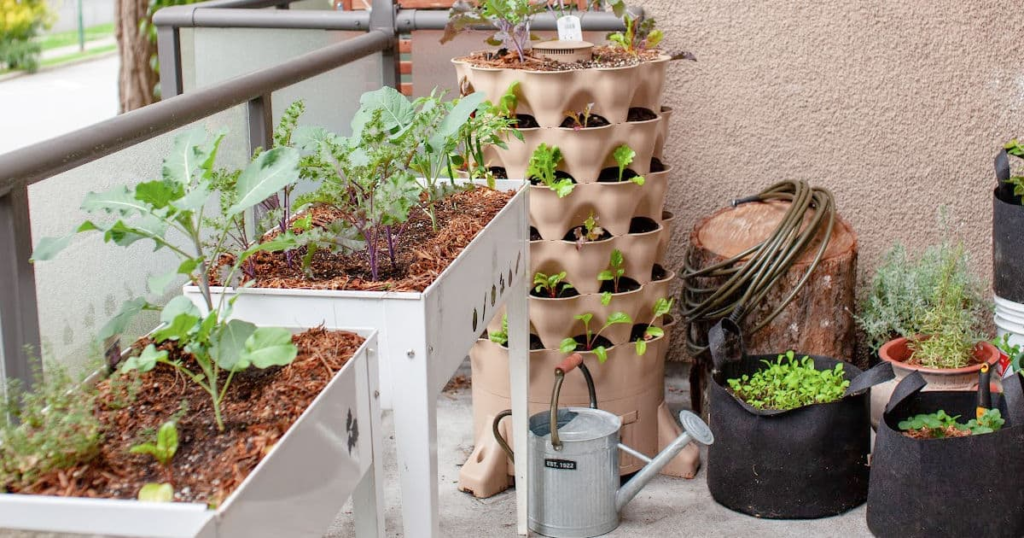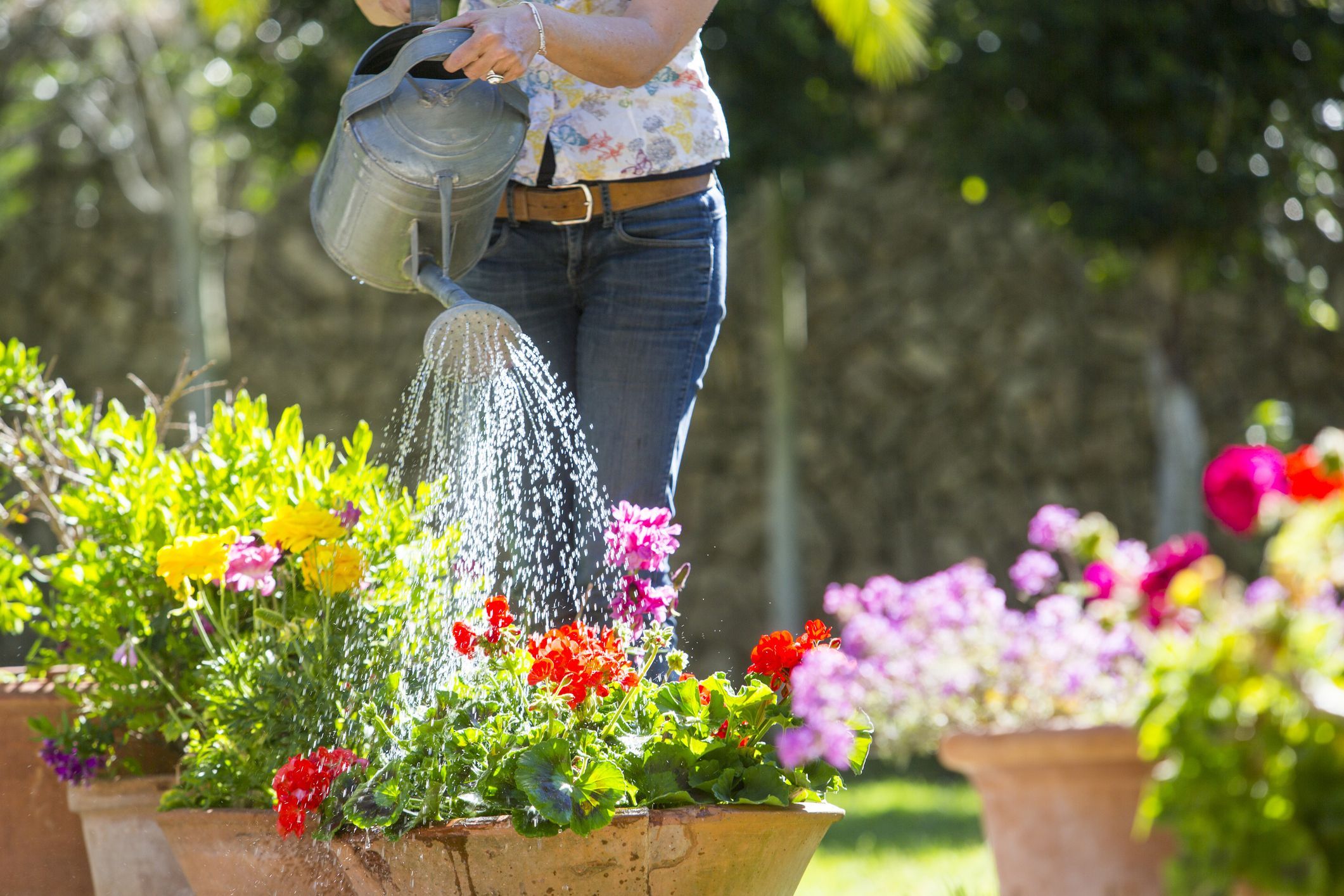Gardening is a great way to get in touch with nature and enjoy the benefits of growing your own fruits, vegetables, and herbs. However, not everyone has the space or resources to maintain a traditional garden. That’s where container gardening comes in. Container gardening is the practice of growing plants in pots, containers, or other types of vessels. It’s a great option for people who have limited space, want to grow plants indoors, or want to add some greenery to their patios, balconies, or rooftops.
In this comprehensive guide, we’ll cover everything you need to know about container gardening, from choosing the right containers and soil to selecting the right plants and caring for them throughout the growing season.
Dchant&Wiiiisen Potato Grow Bags 3 Pack 7 Gallon Plant Grow Bag with Window Flap Breathable Planting and Two Handles Thickened Non-Woven Fabric Gardening Plant Containers for Vegetables & Flowers
$14.99

Choosing the Right Containers:
Container gardening is all about growing plants in pots, containers, or other types of vessels. Choosing the right container is crucial for the success of your container garden. Here are some factors to consider when choosing the right containers for your plants.
Size Matters: How to Choose the Right Size Container
The size of your container depends on the size of your plants and their root system. Larger plants need larger containers to provide enough space for their roots to grow. As a rule of thumb, the container should be at least twice the size of the plant’s root ball. If you’re growing a variety of plants in the same container, make sure to choose a large enough container to accommodate all of them.
Material Matters: Pros and Cons of Different Types of Containers
There are many types of containers available for container gardening, including plastic, ceramic, metal, and terracotta. Each material has its pros and cons.
Plastic containers are lightweight and affordable, but they can degrade over time in direct sunlight.
Ceramic containers are durable and come in a variety of colors and designs, but they are heavy and can break easily.
Metal containers are sturdy and come in a variety of shapes and sizes, but they can rust and get hot in direct sunlight.
Terracotta containers are porous and allow air and water to circulate, but they can dry out quickly and crack in cold temperatures.
Drainage Matters: Why Drainage Holes are Important
Good drainage is crucial for the health of your plants. When water sits in the bottom of a container, it can lead to root rot and other plant diseases. Make sure your container has drainage holes at the bottom to allow excess water to escape. If your container doesn’t have drainage holes, you can create them using a drill.

Selecting the Right Soil:
Soil vs. Potting Mix: What’s the Difference?
Soil is the natural material found in the ground, while potting mix is a specially formulated mix of soil, organic matter, and other ingredients that are designed for container gardening. Potting mix is lighter and has better drainage than regular soil, which is important for container gardening.
The Importance of Nutrients
Plants need nutrients to grow and thrive. When choosing a potting mix, make sure it contains the necessary nutrients, such as nitrogen, phosphorus, and potassium. You can also add organic matter, such as compost or aged manure, to your potting mix to provide additional nutrients.
How to Create the Perfect Soil Mix
To create the perfect soil mix for your container garden, start with a high-quality potting mix and add compost or aged manure to it. Mix it well and add perlite or vermiculite to improve drainage. You can also add slow-release fertilizer to provide your plants with nutrients throughout the growing season.
Picking the Right Plants:
Factors to Consider When Selecting Plants
When selecting plants for your container garden, consider the light requirements, temperature, and humidity needs of your plants. Some plants, such as tomatoes and peppers, require full sun, while others, such as lettuce and spinach, prefer partial shade. Make sure your plants are compatible and have similar growing requirements.
Top 10 Plants for Container Gardening
Here are some of the best plants for container gardening:
- Tomatoes
- Peppers
- Lettuce
- Herbs
- Strawberries
- Blueberries
- Dwarf fruit trees
- Ornamental grasses
- Succulents
- Annual flowers
How to Plant Seeds and Seedlings
When planting seeds and seedlings in containers, make sure to follow the instructions on the seed packet or plant label. Plant seeds at the appropriate depth and spacing, and water them gently. For seedlings, make a small hole in the soil that is big enough to fit the root ball and gently press the soil around the stem.
It’s important to give your plants enough space to grow and thrive. Overcrowding can lead to competition for resources and make it harder for your plants to get the nutrients they need. You can use the “Thriller, Filler, Spiller” technique to create a visually appealing container garden while providing enough space for your plants to grow.
The Thriller plant is the centerpiece of the container and is usually taller and more dramatic than the other plants. The Filler plants are medium-sized and fill the gaps around the Thriller plant, while the Spiller plants are trailing and hang over the edges of the container.
Some popular Thriller plants for container gardening include grasses, ornamental kale, and salvia. Good Filler plants include petunias, marigolds, and impatiens, while Spiller plants include sweet potato vines, ivy, and trailing nasturtiums.

Caring for Your Container Garden:
Watering: How Much is Too Much?
Water is essential for plant growth, but too much water can lead to root rot and other problems. As a general rule, you should water your plants when the soil feels dry to the touch. Use your finger to check the moisture level of the soil, or invest in a moisture meter to make it easier.
The amount of water your plants need will depend on several factors, including the type of plant, the size of the container, and the temperature and humidity levels. In general, most container plants will need to be watered once or twice a week, but some may need more frequent watering.
When watering your container garden, make sure to water deeply to encourage healthy root growth. Water until the excess water starts to drain out of the bottom of the container, but be careful not to overwater.
Fertilizing: When and How to Add Nutrients
Plants need nutrients to grow and thrive, and container plants are no exception. Most potting mixes will contain some nutrients, but they will eventually be depleted over time. To keep your plants healthy, you’ll need to fertilize them regularly.
There are two main types of fertilizers: organic and synthetic. Organic fertilizers are made from natural materials, such as compost, bone meal, and fish emulsion, while synthetic fertilizers are made from chemicals.
Organic fertilizers are a popular choice for container gardening because they provide slow-release nutrients and improve soil structure. Synthetic fertilizers are quicker to act, but they can also be harsh on plants and may lead to nutrient imbalances.
When fertilizing your container garden, make sure to follow the instructions on the fertilizer package. Too much fertilizer can burn your plants and cause them to die, while too little fertilizer can lead to stunted growth.
Pest Control: How to Keep Your Plants Safe
Just like traditional gardens, container gardens are susceptible to pests and diseases. Common pests include aphids, spider mites, and whiteflies, while common diseases include powdery mildew and root rot.
To keep your plants safe, it’s important to monitor them regularly for signs of pests and diseases. Early detection is key to preventing damage and stopping the spread of pests and diseases.
There are several ways to control pests and diseases in your container garden, including handpicking pests, using insecticidal soap or neem oil, and practicing good sanitation. You can also use natural predators, such as ladybugs and praying mantises, to control pests.

FAQs:
Q. What are the benefits of container gardening? A. Container gardening allows you to grow plants in small spaces, such as balconies, patios, or indoors. It also allows you to control the growing environment, which can be beneficial for plants that require specific growing conditions.
Q. Can I grow vegetables in containers? A. Yes, you can grow a variety of vegetables in containers, such as tomatoes, peppers, lettuce, and herbs. Just make sure to choose the right size container and soil and provide your plants with enough light and nutrients.
Q. How often should I water my container garden? A. It depends on the type of plants you’re growing, the size of the container, and the temperature and humidity levels. As a general rule, you should water your plants when the soil feels dry to the touch.
Conclusion:
Container gardening is a fun and rewarding way to grow plants in small spaces or indoors. With the right containers, soil, and plants, you can create a beautiful and productive garden that provides fresh produce, herbs, or flowers throughout the growing season. Remember to choose containers with good drainage, use high-quality soil, select the right plants, and provide your plants with the right care and nutrients. Happy gardening!


